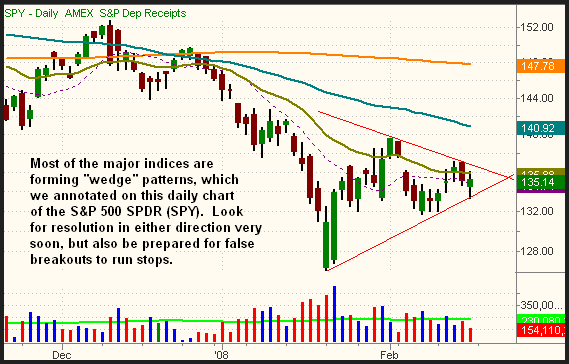| The Wagner Daily ETF Report for February 19 |
| By Deron Wagner |
Published
02/19/2008
|
Stocks
|
Unrated
|
|
|
|
The Wagner Daily ETF Report for February 19
The broad market wrapped up last week on an indecisive note, as the major indices gapped lower on the open, drifted slightly lower in the morning, then reversed much of their losses into the close. The S&P 500 eked out a gain of 0.1%, but the rest of the main stock market indexes finished modestly lower. The Nasdaq Composite lost 0.5%, as both the Dow Jones Industrial Average and S&P Midcap 400 Index slipped 0.2%. The small-cap Russell 2000 was off by 0.5%. The S&P 500 settled at its intraday high, while the rest of the major indices closed in the upper third of their intraday ranges.
Turnover was mixed in last Friday's monthly options expiration day. Total volume in the NYSE increased 5% above the previous day's level. Trading in the Nasdaq decreased 10%. The S&P 500's gain on higher volume was positive, but an advance of just 0.1% doesn't quite qualify as a bullish "accumulation day." In the Nasdaq, declining volume exceeded advancing volume by a margin of 2 to 1. The NYSE adv/dec volume ratio was flat.
Going into this week, be prepared for volatility in either direction because the broad market is essentially in "no man's land." On a near-term basis, it's bullish that the S&P 500 has formed a "higher low" above the January lows. However, a "lower high" may also have formed from the February 1 highs. This means that a "wedge" chart pattern has formed on daily charts of most of the major indices. This is illustrated on the daily chart of the S&P 500 SPDR (SPY), a popular ETF proxy for the S&P 500 Index:

The point of a "wedge" pattern is simply to be aware that a powerful move in either direction will soon take place. The longer the "wedge" forms, the more volatility in the market contracts. The greater the volatility contraction, the greater the subsequent volatility expansion. When a "wedge" pattern has formed, one looks for an eventual move above the upper channel or below the lower channel. Typically, the pattern resolves itself in the direction of the dominant trend. Stocks have been in a primary downtrend since October of 2007, so the odds favor a resolution to the downside and a test of the January lows in the near future. Nevertheless, don't be surprised if the S&P 500 spikes above the upper channel of its "wedge" for a few days, squeezes all the shorts, then fails the upside breakout. Further, remember that the 20-day exponential moving averages have also been acting as resistance for the past month.
In the pre-market, both the S&P and Nasdaq futures are positioned for substantial upside opening gaps. Poised to open more than 1% higher, both the S&P and Nasdaq will likely test resistance of last week's highs this morning. If stocks move above last week's highs and hold for at least the first thirty minutes, it will set a rather bullish tone for the broad market. The next major test of resistance for the broad-based indexes would be the February 1 highs. With the "wedge" patterns and pivotal areas of near-term support/resistance in play, we plan to lay low with new trade entries until the market clearly shows its hand for the direction of its next major move. When that happens, likely within the next few days, we'll take an updated look at which industries or specialty ETFs are showing the most relative strength or weakness to the broad market.
Open ETF positions:
Long - UNG, SDS, SKF
Short - (none)
Deron Wagner is the Founder and Head Trader of both Morpheus Capital LP, a U.S. hedge fund, and Morpheus Trading Group, a trader education firm launched in 2001 that provides daily technical analysis of the leading ETFs and stocks. For a free trial to the full version of The Wagner Daily or to learn about Wagner's other services, visit MorpheusTrading.com or send an e-mail to deron@morpheustrading.com.
|